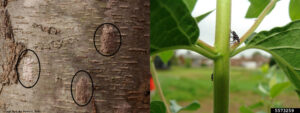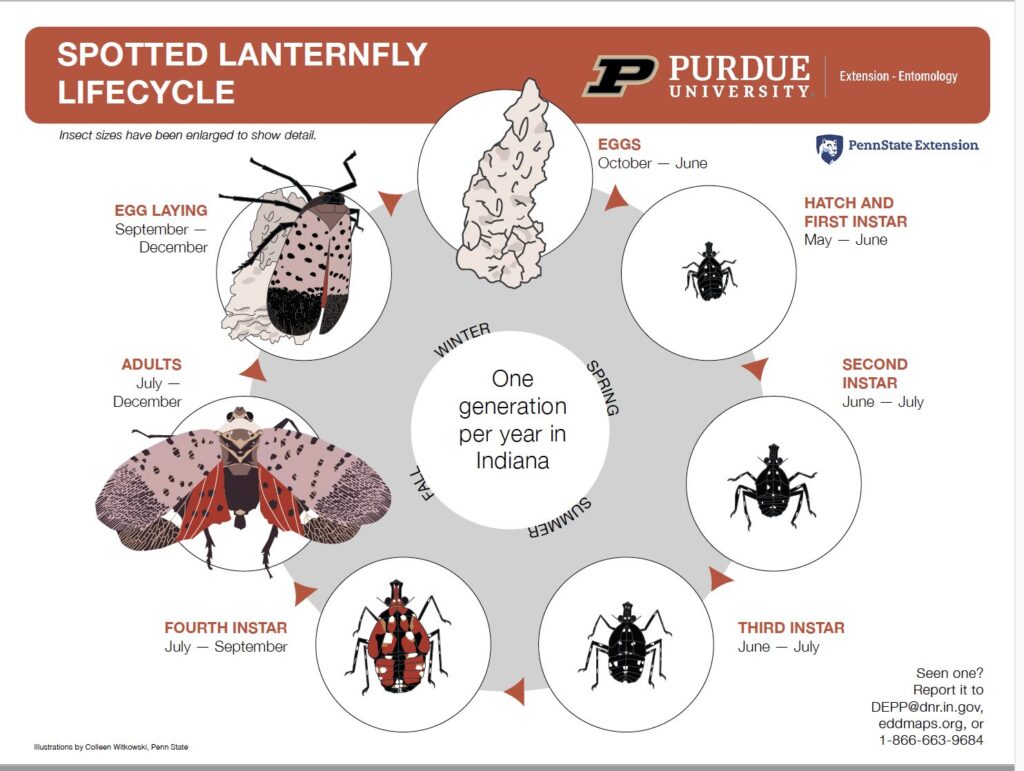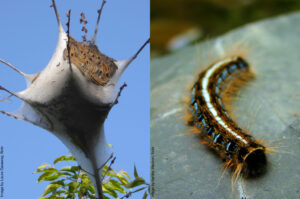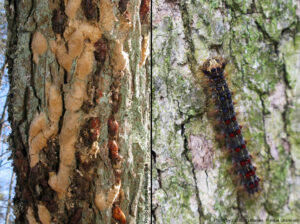The bursting of buds on the trees signals the arrival of spring, but warm weather also portends the hatching of pest insects. Three that feed on trees and shrubs to watch out for are spotted lanternfly, eastern tent caterpillar, and spongy moth.
Spotted lanternfly

Figure 1. Spotted lanternfly eggs can be very difficult to detect as they easily blend in with their environment. The photo on the left shows three spotted lanternfly egg masses on bark. Note that they all have a putty or mud-like texture and color. The photo on the right shows an early instar spotted lanternfly nymph. Note that it holds itself at about a 45 degree angle. Images by Luke Hearon, flickr and Eric R. Day, Virginia Polytechnic Institute and State University.
Spotted lanternfly is an invasive insect that can be found on the East Coast and was discovered in Indiana last summer. It has been found in the southeastern part of the state, but there may be other populations that have not yet been reported. Depending on temperatures, spotted lanternfly egg hatch can begin anywhere from late April to May. Now is the time to scout for these insects. Stay vigilant for this insect and report any sightings.
Host plants
Spotted lanternfly nymphs (juvenile life stage) prefer plants with thin bark like roses, grapes, tree of heaven, and perennials. They may also be found on saplings and new shoots of their other host plants like birch, black walnut, fruit trees, and maple.
Damage
Spotted lanternfly feeding can kill grape vines within a single summer. Intense feeding can cause dieback of small branches of other host plants. Additionally, early study results suggest that heavy spotted lanternfly feeding can weaken trees and plants sometimes making them more susceptible to other stresses like drought and disease. Researchers are still learning about the long-term impacts of this insect so we strongly recommend staying up-to-date with the current research regarding its impact and management.
Identification
Early instars of spotted lanternfly are black with white spots (figure 1). They can sometimes be confused with ticks but can be distinguished by their behavior. Ticks hold themselves flat to a surface and will crawl away when disturbed whereas spotted lanternfly hold themselves at a 45 degree angle and will jump away when disturbed. Fourth instar spotted lanternfly have red patches on their bodies and adult lanternflies have brightly colored wings with bold red patches and a white stripe (figure 2).

Figure 2. Spotted lanternfly can be found in their nymphal and adult stages from about May to December and as eggs overwinter. The timing listed is approximate and dependent on temperature.
What to do now
- Scout for egg masses-Spotted lanternfly egg masses resemble splotches of mud or putty and can be found on just about any surface outside (cars, garden equipment, houses, lightbulbs, etc.; figure 2).
- Scout for nymphs-Nymphs move from tree to tree early in the season (figure 2). Look for them on their favored host plants like grape and tree of heaven.
- Make plans to remove tree of heaven. Spotted lanternfly can survive without tree of heaven, but it is one of their strongly preferred host plants and it is invasive itself. Removing tree of heaven may help slow down spotted lanternfly. Learn how to remove it here.
Resources
- Indiana Spotted Lanternfly Information
- Tree of Heaven Management Video
- Penn State Management Guide
- Report them if you see them (EDDMapS Website, Email: DEPP@dnr.in.gov, or 1-866 NO EXOTIC (1-866-663-9684)).
Eastern Tent caterpillars
Eastern tent caterpillars begin to emerge around budbreak and construct silk tents on trees. Though these caterpillars rarely cause serious damage to trees, they are considered unsightly by some.
Identification

Figure 3. Tent caterpillars build silk tents that they rest on and hide in throughout the day. They often venture out to surrounding branches to feed during the day. Caterpillars are hairy and typically have a white to cream colored stripe down their backs and blue spots on their sides. Photos by Laura Gasaway, flickr and Ashley Waldron, flickr.
Eastern tent caterpillars have blue-black bodies with white and gold stripes down their backs, blueish spots, and golden hair (figure 3). They are typically found in large groups until their last instar when they disperse. These caterpillars build messy silk webs that are called tents on tree branches (figure 3). They retreat to these tents throughout the day and at night. Caterpillars sometimes form lines from their tent to feeding sites.
Host plants
Eastern tent caterpillars can eat a wide range of plants but tend to prefer plants in the Rosaceae family like cherry, apple, and chokecherry. They can also sometimes be found on maple and hawthorn.
Damage
Eastern tent caterpillars typically cause more cosmetic damage than severe injury to trees and bushes. Caterpillars defoliate sections of trees or fully defoliate small bushes. Healthy trees may reflush later in the summer and typically show no signs of long-term impact. Tent caterpillars very rarely cause serious injury. In extreme cases, stressed trees may be more severely damaged.
What to do now
- Scout for caterpillars-At this time of year, tent caterpillars are still typically small and haven’t had time to do much damage.
- If you’re not concerned about damage, you can leave them be. Tent caterpillars cause minor damage and are a great food source for wildlife.
- If you’re concerned about damage, but don’t want to kill them you can snip the twigs with the tent caterpillars or gently pull the tents off at night. Place them on another tree or shrub in a well-lit area like a forest edge where you are less concerned about leaf damage. Wear gloves if you use this method as some people are allergic to the hairs on the caterpillars.
- If you’re concerned about damage and need to kill them you can use the same control methods as for fall webworms.
Resources
Spongy moth (formerly gypsy moth)
Spongy moth (formally known as gypsy moth) is an invasive insect typically found in northern Indiana as well as much of the East Coast, Michigan, and Wisconsin but it can also appear in isolated populations in other areas. A good rule of thumb is that generally a wet spring means low levels of spongy moth and a dry spring can mean high levels of spongy moth, though there are, of course, exceptions.
Identification

Figure 4. Spongy moth caterpillars lay brown egg masses covered in hair. They can be found on just about any surface outside and in outbreak years may be clumped together. Their caterpillars have blue-black bodies with blue and red bumps on their backs in two rows. Photos by Sandra Richard, flickr and Elizabeth Barnes, Purdue University.
Spongy moth egg masses are light brown, oval, and furry (figure 4). The caterpillars are extremely small when they hatch in April and May, but can grow up to 2 inches later in the summer. They have blue-black, hairy bodies with rows of paired blue and red spots down their backs (figure 4).
Host plants
Spongy moth caterpillars strongly prefer oak trees but will also eat willow, sweetgum, poplar, apple, pine, and over 500 other species of plants. They generally start with oaks and move to these other plants if they run out of leaves.
Damage
Spongy moths can completely defoliate trees in one year and seem to disappear the next. They generally only cause serious problems for tree health during outbreak years which are more likely to occur following a dry spring. The seriousness of the damage to trees depends on the species of tree and the number of other stresses it experiences before and after the defoliation. You can learn more about spongy moth damage here. Arborists and other green industry professionals can be consulted if you have concerns about the health of a specific tree.
What to do now
- Scout for egg masses-There’s still time in most areas to look for and scrape egg masses. Check on sheltered areas like house siding, tree trunks, on rocks, and car tires. Gently scrape the eggs off with a paint scraper or other hard piece of plastic and dump them in soapy water. Leave them in the water for about two days before disposing of them.
- If you live in an area with an establish population of spongy moth, familiarize yourself with management options so that you can quickly respond should there be an outbreak later in the summer.
- Report them if you see them (EDDMapS Website, Email: DEPP@dnr.in.gov, or 1-866 NO EXOTIC (1-866-663-9684)).
Resources
- Spongy Moth In Indiana
- Spongy Moth Q&A’s for Christmas Tree Growers & Nursery Producers
- Q&A’s About Using BTK to Control Spongy Moth
- Q&A’s About Pheromones & Controlling Spongy Moth
- Indiana DNR’s Spongy Moth Page
- Spongy Moth Distribution
- Everything you need to know about spongy moth in a half an hour